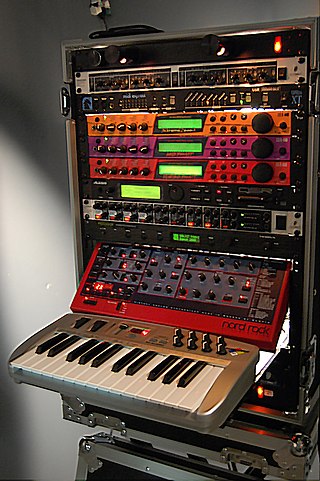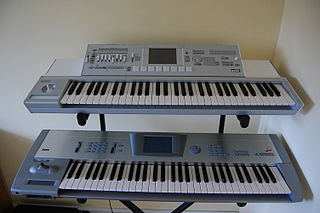
MIDI is a technical standard that describes a communication protocol, digital interface, and electrical connectors that connect a wide variety of electronic musical instruments, computers, and related audio devices for playing, editing, and recording music.

Roland Corporation is a Japanese manufacturer of electronic musical instruments, electronic equipment, and software. It was founded by Ikutaro Kakehashi in Osaka on 18 April 1972. In 2005, its headquarters relocated to Hamamatsu in Shizuoka Prefecture. It has factories in Malaysia, Taiwan, Japan, and the United States. As of December 2022, it employed 2,783 people. In 2014, it was subject to a management buyout by its CEO, Junichi Miki, supported by Taiyo Pacific Partners.

The Roland SH-101 is an analog synthesizer manufactured by the Roland Corporation between 1982 and 1986. Though it was something of a commercial failure during the time of its manufacture, it later became a staple of electronic music in the 1990s, particularly house music.

The Korg Triton is a music workstation synthesizer, featuring digital sampling and sequencing, released in 1999. It uses Korg's HI Synthesis tone generator and was eventually available in several model variants with numerous upgrade options. The Triton became renowned as a benchmark of keyboard technology, and has been widely featured in music videos and live concerts. At the NAMM 2007, Korg announced the Korg M3 as its successor.

The Roland MT-32 Multi-Timbre Sound Module is a MIDI synthesizer module first released in 1987 by Roland Corporation. It was originally marketed to amateur musicians as a budget external synthesizer with an original list price of $695. However, it became more famous along with its compatible modules as an early de facto standard in computer music. Since it was made prior to the release of the General MIDI standard, it uses its own proprietary format for MIDI file playback.

The Jupiter-8, or JP-8, is an eight-voice polyphonic analog subtractive synthesizer introduced by Roland Corporation in early 1981.

A MIDI controller is any hardware or software that generates and transmits Musical Instrument Digital Interface (MIDI) data to MIDI-enabled devices, typically to trigger sounds and control parameters of an electronic music performance. They most often use a musical keyboard to send data about the pitch of notes to play, although a MIDI controller may trigger lighting and other effects. A wind controller has a sensor that converts breath pressure to volume information and lip pressure to control pitch. Controllers for percussion and stringed instruments exist, as well as specialized and experimental devices. Some MIDI controllers are used in association with specific digital audio workstation software. The original MIDI specification has been extended to include a greater range of control features.
The Roland Juno-106 is a synthesizer released by Roland Corporation in February 1984.

The RolandJuno-60 is an analog synthesizer manufactured by the Roland Corporation between 1982 and 1984. It followed the Juno-6, an almost identical synthesizer released months earlier. The Juno synthesizers introduced Roland's digitally controlled oscillators, allowing for greatly improved tuning stability over its competitors.
Arturia is a French electronics company founded in 1999 and based in Grenoble, France. The company designs and manufactures audio interfaces and electronic musical instruments, including software synthesizers, drum machines, analog synthesizers, digital synthesizers, MIDI controllers, sequencers, and mobile apps.
The Fantom-X (Xa/X6/X7/X8/XR) is a music workstation/synthesizer produced by Roland Corporation. It was introduced in 2004 as an upgrade from the Fantom S series. The Fantom-X competes with the Korg Triton/Triton Extreme, the Yamaha Motif ES and other similar large-scope keyboards such as the discontinued Alesis Fusion. In 2008 it was succeeded by the Fantom-G*, which was devised to compete with the new Korg and Yamaha flagship keyboards.

The Roland JD-800 is a digital synthesizer that was manufactured between 1991 and 1996. It features many knobs and sliders for patch editing and performance control — features that some manufacturers, including Roland, had been omitting in the name of streamlining since the inception of the Yamaha DX7. The JD-800 thus became very popular with musicians who wished to take a hands-on approach to patch programming. The introduction in the manual states that Roland's intention with the JD-800 was to "return to the roots of synthesis".
The Roland SH-201 is a discontinued 49 key, 10-voice polyphonic virtual analogue synthesizer introduced in 2006 by the Roland Corporation. The SH-201 was discontinued in 2010. Roland introduced its successor, the Roland SH-01 Gaia, at the 2010 NAMM Show.
The Roland JD-990 Super JD is a module version of Roland JD-800 synthesizer with expanded capabilities, which was released in 1993. JD-990 is a multitimbral synthesizer utilizing 'wave-table' sample-based synthesis technology. It is equipped with 6 MB of ROM containing sampled PCM waveforms, four sets of stereo outputs that are assignable to individual, internal, instruments, and standard MIDI in/out/through ports. JD-990 has a large LCD display and programming takes place through a keypad on the front panel of the unit. The unit can generate multi-timbral sounds reminiscent of the vintage analogue synthesizers but is also capable of generation of modern digital textures. There are several expansion boards available for JD-990 that can be installed in the provided expansion slot in the chassis of the unit.
The D-Beam is a Roland synthesizers interface that can control and manipulate sound and effects via the user's hand movements interacting with an infrared beam of light.

The Seaboard is a musical keyboard-style MIDI controller manufactured by the British music technology company ROLI. It has a continuous sensor-embedded flexible rubber surface for playing the keys instead of traditional lever-style "moving keys". Some models, like the RISE Seaboard Grand, have an onboard sound engine. It has what the manufacturer calls "5D technology" which consists of five types of responsiveness to player actions: "strike", "glide" and "press", front to rear movement "slide" sensitivity, and release–velocity "lift". These responsiveness tools can be used to play the Seaboard with microtonal pitch bend sounds, by moving the finger from note to note, or trigger a vibrato effect into a string patch just by wiggling the finger, which would not be possible on a traditional MIDI controller using only the keys. The Seaboard also features polyphonic aftertouch, and a built-in USB- charged battery. There are three Seaboard models: the small minikey BLOCK, the RISE, and the GRAND, an 88-key keyboard with an onboard sound engine.
The Roland V-Synth is a polyphonic synthesizer. It was released 2003 and was Roland's flagship synthesizer at the time. It combines multiple oscillator technologies and a built in sampler. It also features an arpeggiator and COSM filtering to aid the creation of new sounds.
The Jupiter-80 is a discontinued 256-voice polyphonic virtual analog subtractive synthesizer introduced by Roland Corporation in 2011. The Jupiter-80 is a part of Roland's flagship long-running synthesizer series, which began with the Jupiter-4 between the years of 1978 and 1981. The Jupiter-80 was shortly followed by the Jupiter-50, which is a combination of both the JP-80 and the JUNO series. It was succeeded by the Jupiter-X and Jupiter-Xm in 2019.
The Jupiter-50 is a discontinued 128 voice polyphonic digital subtractive synthesizer introduced by Roland Corporation in 2011. The Jupiter-50 is a part of Roland's flagship synthesizer series, which began with the Jupiter-4 between the years of 1978 and 1981. The Jupiter-50 is considered a hybrid/combination of both the Jupiter-80 and the JUNO series.
The VK-8 Combo Organ is a discontinued electronic keyboard introduced in 2002, which simulates the sound of an electromechanical tonewheel-based Hammond organ. The VK-8 is both an improvement and successor to both the VK-7 and VK-77. The VK-8 itself was succeeded by the VK-88.










